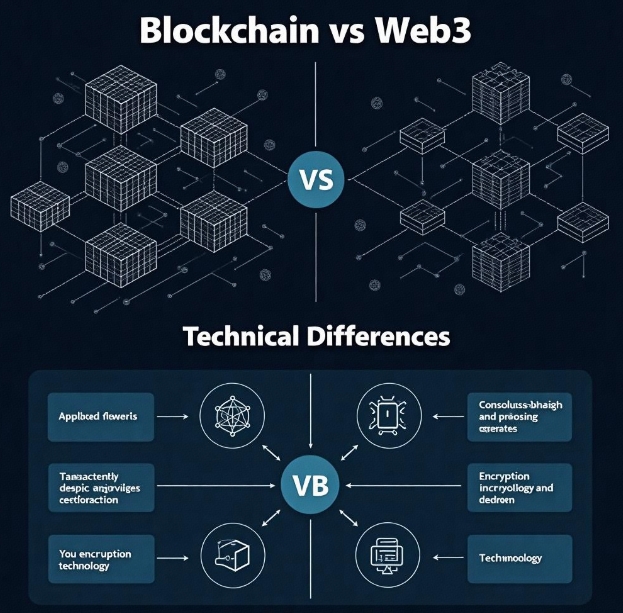Detailed explanation of the core differences between blockchain and Web3 development
- latest articles
- 1.DApp Development & Customization: Merging Diverse Market Needs with User Experience 2.Analysis of the Core Technical System in DApp Project Development 3.How to achieve cross-chain interoperability in Web3 projects? 4.How does the tokenization of points reconstruct the e-commerce ecosystem? 5.How to Set and Track Data Metrics for a Points Mall? 6.What is DApp Development? Core Concepts and Technical Analysis 7.Inventory of commonly used Web3 development tools and usage tips 8.Development of a Distribution System Integrated with Social E-commerce 9.Six Key Steps for Businesses to Build a Points Mall System 10.What is DApp Development? A Comprehensive Guide from Concept to Implementation
- Popular Articles
- 1.Future Trends and Technology Predictions for APP Development in 2025 2.Analysis of the DeFi Ecosystem: How Developers Can Participate in Decentralized Finance Innovation 3.From Zero to One: How PI Mall Revolutionizes the Traditional E-commerce Model 4.DAPP Development | Best Practices for Professional Customization and Rapid Launch 5.Recommended by the Web3 developer community: the most noteworthy forums and resources 6.From Cloud Computing to Computing Power Leasing: Building a Flexible and Scalable Computing Resource Platform 7.How to Develop a Successful Douyin Mini Program: Technical Architecture and Best Practices 8.Shared Bike System APP: The Convenient Choice in the Era of Smart Travel 9.How to Create a Successful Dating App: From Needs Analysis to User Experience Design 10.From Design to Development: The Complete Process of Bringing an APP Idea to Life
In recent years, blockchain technology and Web3 concepts have become hot topics in the tech field. They represent two important technological and developmental directions, driving transformations across various industries from finance to data privacy. However, despite their many similarities, they have significant fundamental differences. This article will delve into the core distinctions between blockchain and Web3 development, helping readers better understand how each plays its role in modern technology.
I. Basic Concepts of Blockchain
Blockchain is a distributed ledger technology that initially gained widespread recognition through Bitcoin. Its fundamental principle involves decentralized network nodes collectively verifying and recording data without a central controlling authority. This data is packaged into "blocks," each containing the hash of the previous block, ensuring data immutability and security. Blockchain technology can be widely applied in fields such as finance, supply chain, healthcare, and copyright protection.
The core characteristics of blockchain include:
Decentralization: The blockchain network does not rely on a single central server; all nodes collectively maintain the ledger's updates.
Transparency: Transactions on the blockchain are visible to everyone, and all transaction records are immutable, ensuring data credibility.
Security: Data security is ensured through encryption technology, preventing illegal tampering.
Blockchain applications first achieved breakthroughs in the financial sector, especially with the emergence of cryptocurrencies, where the value of blockchain began to be widely recognized. Bitcoin, as the first digital currency based on blockchain technology, demonstrated the potential of blockchain in decentralized transaction systems.
II. Basic Concepts of Web3
Web3, or Web 3.0, is a decentralized internet development concept that represents a departure from the traditional Web2.0 model. In the Web2.0 era, the creation and management of internet content were concentrated in the hands of a few major companies, with users' personal data and privacy often controlled by these corporations. Web3 aims to establish a more open, decentralized internet environment through blockchain technology and smart contracts, allowing users to regain ownership of their data.
The core characteristics of Web3 include:
Decentralization: The core philosophy of Web3 is decentralization, removing the single centralized service providers of traditional Web2.0 and giving users more control in the digital world.
User Autonomy: Through smart contracts and blockchain technology, Web3 enables users to control their own data, engage in trustless transactions and interactions, avoiding reliance on central platforms.
Token Economy: The Web3 ecosystem commonly involves the use of tokens, allowing users to achieve asset circulation, exchange, and appreciation through cryptocurrencies and tokens.
Web3 is not just a technological development; it also encompasses broader philosophical concepts, especially in areas like user privacy, data rights, and value exchange. The goal of Web3 is to break down the information barriers in the current internet, enabling every user to freely express, trade, and interact on a decentralized platform.
III. Core Differences Between Blockchain and Web3
Although blockchain and Web3 have many overlaps, especially in their goals of decentralization and trustlessness, they have fundamental differences in concept and application levels. Here are several core distinctions between blockchain and Web3 development:
1. Differences in Technical Implementation
Blockchain technology is essentially a distributed ledger technology focused on how to store and verify data in a decentralized manner. It ensures data consistency through nodes in the blockchain network, thereby guaranteeing data security and immutability. Blockchain can be used independently in scenarios such as finance, supply chain management, and data storage.
Web3, on the other hand, not only relies on blockchain technology but also integrates various technical means such as smart contracts, decentralized applications (DApps), cryptocurrencies, and decentralized storage. The core of Web3 lies in establishing a decentralized, user-autonomous network architecture and providing more applications and services based on this foundation.
2. Differences in Functional Goals
The primary goal of blockchain is to solve the "trust problem," ensuring the security and transparency of transactions or data exchanges without the need for third-party trust. Blockchain focuses on providing decentralized data storage and verification mechanisms for various industries, ensuring data security and integrity.
In contrast, Web3's goals are more macro, addressing not only decentralized data storage but also how to build a fairer, more transparent, and free internet ecosystem through decentralization. Web3 includes blockchain technology but also emphasizes helping users regain control over their data and digital assets through token economic incentives, decentralized identity (DID), and self-sovereign identity (SSI).
3. Differences in Application Scenarios
The application scenarios of blockchain technology are mainly concentrated in areas such as digital currencies, smart contracts, and supply chain management. For example, Bitcoin is a decentralized cryptocurrency based on blockchain, while Ethereum enables decentralized applications and trustless transactions through smart contracts.
Web3's application scenarios are broader and more in-depth. In addition to the above blockchain-based applications, Web3 also includes decentralized finance (DeFi), decentralized social platforms (such as decentralized social media DApps), NFT (non-fungible token) markets, and decentralized storage platforms. Through more complex decentralized protocols and applications, Web3 promotes the establishment of a new digital economy ecosystem.
4. Differences in User Interaction Methods
In blockchain, users primarily conduct transactions and identity verification through wallets and private keys. Interactions in blockchain are usually simpler, with users mainly participating in transactions and verification processes or earning rewards through methods like mining.
Web3's interaction methods are richer and more diverse. Users not only interact with decentralized platforms through wallets and private keys but can also participate in ecosystem building through token incentives, engage in governance, have decision-making power in platforms, and even directly own decentralized applications. For example, DAO (decentralized autonomous organization) is a form of organization in Web3 where users can participate in project decisions by holding governance tokens.
5. Differences in Governance Structures
The governance structure of blockchain mainly consists of nodes in the blockchain network, which are responsible for verifying transactions and updating the ledger. Blockchain networks typically adopt protocol-level governance, usually through consensus algorithms (such as PoW, PoS, etc.) to decide which nodes participate in network verification and decision-making.
Web3's governance structure is more diverse. Web3 not only relies on blockchain's decentralized consensus mechanisms but also encourages the formation and participation of decentralized communities. Web3 governance is often based on token voting mechanisms, allowing community members to participate in decision-making processes through forms like DAOs, forming a decentralized governance model.
IV. Future Development of Blockchain and Web3
The development of blockchain technology and Web3 complement and promote each other. Blockchain provides the foundational decentralized architecture for Web3, while Web3 drives the widespread adoption of blockchain technology in practical applications. In the future, as technology matures and user demands evolve, blockchain and Web3 will demonstrate greater potential in the following areas:
Popularization of Decentralized Finance: DeFi, as an important component of Web3, will transform the traditional financial system, providing more decentralized financial services and lowering the barriers and costs of financial transactions.
Realization of Decentralized Identity: Decentralized identity (DID) in Web3 will provide users with more secure and private identity verification methods, protecting the privacy and security of personal data.
Wide Application of NFTs and Digital Assets: NFTs in Web3 will bring new value exchange methods to industries such as art, entertainment, and copyright, promoting the circulation and application of digital assets.
Overall, although blockchain and Web3 have significant differences in technical implementation and application scenarios, they collectively drive the development of a new, decentralized, transparent, and fair internet world. As these two technologies continue to evolve and integrate, the future internet will become more open and free, with users having more control and participation rights, ushering in a new digital era.
Conclusion
The development of blockchain and Web3 is not only technological progress but also an innovation in philosophy. From blockchain's decentralized, immutable ledger to Web3's decentralized internet and user-autonomy philosophy, they are driving the transformation of the global digital economy. Whether as technical personnel, enterprises, or ordinary users, everyone should pay attention to this wave of digitalization, seize this historic opportunity, and embrace a more open and free future.
-

How to achieve cross-chain interoperability in Web3 projects?
With the continuous development of WEB3 technology, Web3 has gradually become an···
-

Inventory of commonly used Web3 development tools and usage tips
With the continuous development of blockchain technology, Web3 has become a hot ···
-

Web3 development trend prediction: analysis of future technology directions and application scenarios
With the gradual development of blockchain technology, the concept of Web3 has m···

 Blockchain
Blockchain












